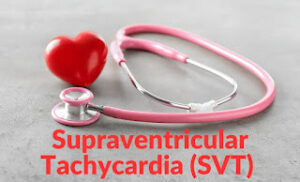Understanding Supraventricular Tachycardia (SVT) and its Awareness Month
Supraventricular Tachycardia (SVT) is a heart rhythm disorder that affects millions of individuals worldwide. Understanding its nuances, signs, and symptoms is crucial for timely diagnosis and management. June marks the Supraventricular Tachycardia (SVT) Awareness Month, dedicated to shedding light on this condition and fostering support for those affected.
 |
| Supraventricular Tachycardia (SVT) Awareness Month 2025 |
What is Supraventricular Tachycardia (SVT)?
Supraventricular Tachycardia (SVT) is a condition characterized by a rapid heart rate originating above the heart’s ventricles. This rapid heartbeat can lead to palpitations, shortness of breath, chest pain, dizziness, and even fainting spells.
When is Supraventricular Tachycardia (SVT) Awareness Month?
Supraventricular Tachycardia (SVT) Awareness Month is observed throughout June, with the primary focus on raising awareness, providing support, and improving access to care for individuals grappling with SVT.
What is the color for Supraventricular Tachycardia (SVT) Awareness?
The color red symbolizes Supraventricular Tachycardia (SVT) Awareness, and it holds significance on June 5th specifically. This vibrant hue represents the collective efforts to raise awareness about SVT and advocate for better understanding and management of the condition.
Show your support for Supraventricular Tachycardia (SVT) Awareness Month with our vibrant red campaign t-shirt! Raise awareness and promote heart health.
|
|
| Supraventricular Tachycardia (SVT) Awareness Month 2025 |
What causes Supraventricular Tachycardia (SVT)?
Several factors can contribute to the onset of SVT, including abnormalities in the heart’s electrical pathways, congenital heart defects, stress, caffeine consumption, and certain medications. Understanding these triggers can aid in both prevention and management strategies.
What are the first signs of Supraventricular Tachycardia (SVT)?
The initial signs of SVT may vary among individuals but commonly include a rapid heartbeat, palpitations, chest discomfort, dizziness, lightheadedness, and shortness of breath. Recognizing these symptoms early on is crucial for seeking prompt medical attention.
How is Supraventricular Tachycardia (SVT) diagnosed?
Diagnosing SVT typically involves a thorough medical history review, physical examination, and diagnostic tests such as electrocardiograms (ECG/EKG), Holter monitoring, echocardiograms, and electrophysiology studies. These tests help healthcare professionals identify the specific type of SVT and tailor treatment accordingly.
Supraventricular Tachycardia (SVT) symptoms
Symptoms of SVT can range from mild to severe and may include:
- Rapid heartbeat
- Palpitations
- Chest pain or discomfort
- Dizziness or lightheadedness
- Shortness of breath
- Fainting spells (syncope)
Supraventricular Tachycardia (SVT) treatment
Treatment strategies for SVT aim to control symptoms, prevent future episodes, and reduce the risk of complications. Depending on the severity and frequency of episodes, treatment options may include:
- Vagal maneuvers (such as coughing or bearing down);
- Medications (beta-blockers, calcium channel blockers, antiarrhythmics);
- Catheter ablation;
- Implantable devices (pacemakers or implantable cardioverter-defibrillators);
- Lifestyle modifications (stress management, avoiding triggers like caffeine or alcohol).
Conclusion
Supraventricular Tachycardia (SVT) Awareness Month serves as a crucial platform to educate the public about this often-overlooked heart rhythm disorder. By fostering awareness, understanding, and support, we can empower individuals living with SVT to lead healthier lives and access the care they need. Let’s unite in the fight against SVT and advocate for a heart-healthy future for all.

